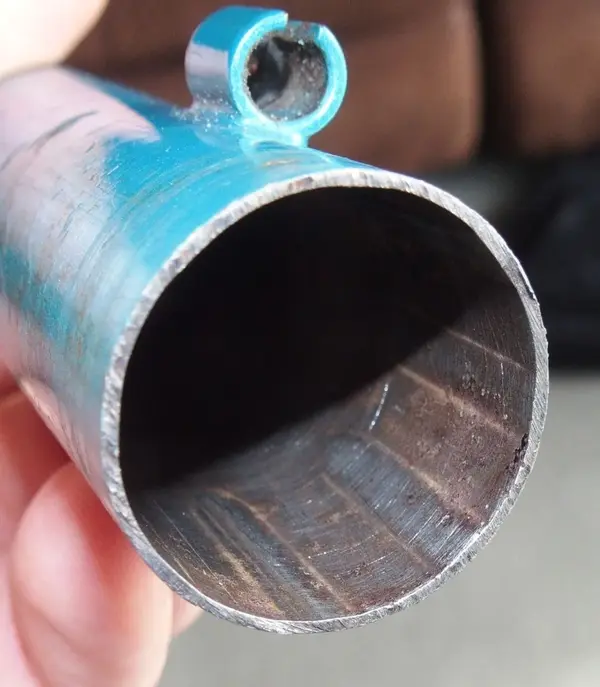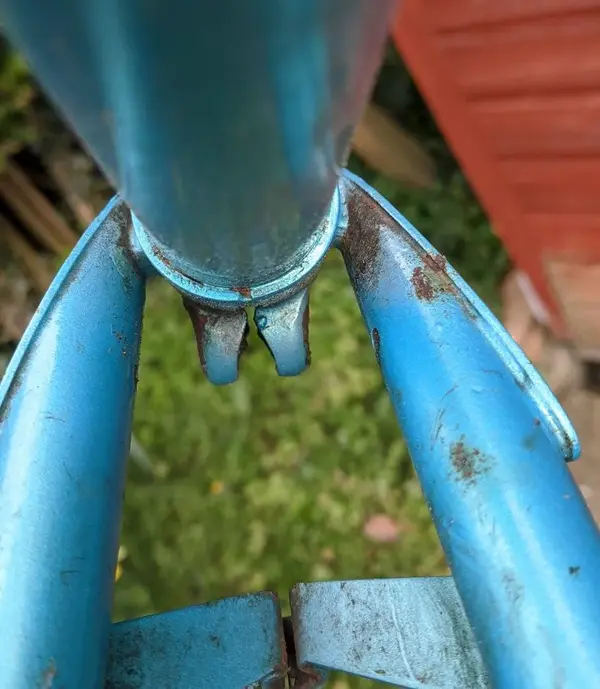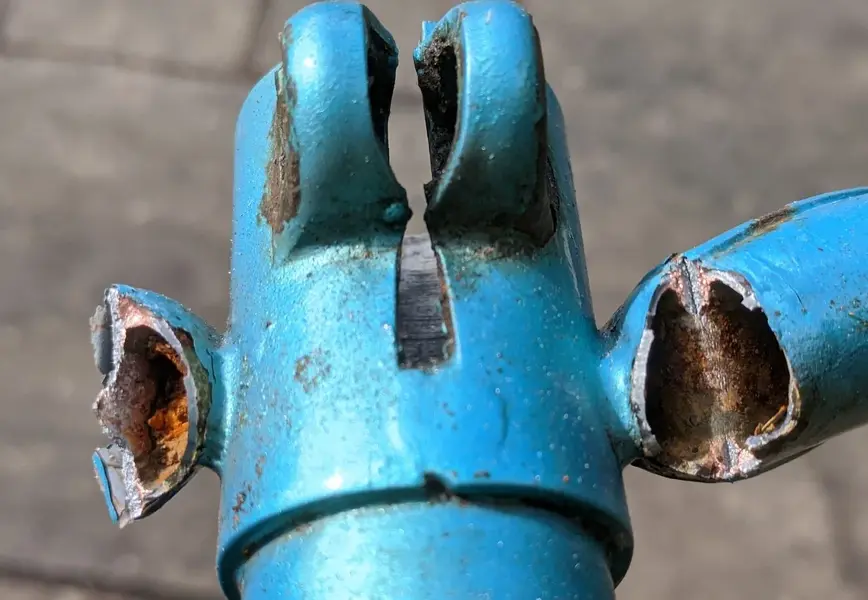The following is some background to the Reynolds K2 tube set with observations and images (see end) from cutting up a 1992 Peak frame.
Reynolds K2 tubing was designed for lugged construction and was used for the Raleigh Off Road series of 1992/3 comprising the Summit/Peak/Apex/Ravine & Strata. It was also used in the same form for the M-Trax steel bike range in 1994/5. Elements of the tube design may have been carried over into the short-lived Tig weldable Optima tube set introduced in 1996.
Raleigh described the new “very, very special” K2 double butted tube set in their 1992/3 brochures, but detailed information from Reynolds is unavailable. A good article can be found on the Vintage Steel Rider where it is asserted that K2 is related to Reynolds 501, 700 and 708. This revolves around the vague recollection of an ex-Reynolds employee, but I have always had a problem with his version. 501 is seamed, but from observation K2 is seamless. It may be made from the same or similar base steel, but that’s where the similarity appears to end. The tube set to which K2 is most closely related is Reynolds 731OS Race. It shares the same oversized elements (down and top tube + seat stays), the same butted rib design and all the same outside tube dimensions. Both came to market in 1992, one for road and one for mountain use. The only difference between them seems to be the base material; Reynolds Cromoly v Mangmoly and the material thickness.
Reynolds 731 OS Race was a high end tube set for larger and stronger competitive road racer applications and data for it can be found on the internet. Like the Reynolds 708 variant that preceded it, 731 had a limited take-up and it is rare to find a bike built with it now. Wall thicknesses down to 0.5mm were employed whereas 0.8mm would seem to be the minimum with K2. Full length rib reinforced 708 could not be described as double butted which harmed its sales, but 731 was rib reinforced at the ends only, so could be.
According to Reynolds, the Mangmoly 700, 708 & 731 tube sets underwent extra process that work hardened them slightly and gave them better UTS than normal 531. The same may be the case for the K2 CroMo, hence the silly emphasis about 52 tons tensile strength on the oversized Reynolds sticker.
K2 Tube data is as follows from my observations and measurements:
Material: CroMo, seamless, butted or full length ribbed.
Toptube: 28.6 OD, double butted with 8 lateral ribs at the ends, 0.8mm thickness middle, 0.8mm/1.0mm alternating on butt ends.
Downtube: 31.7 OD, full length with 8 longitudinal ribs. 0.8mm/1.0mm alternating.
Seat tube: 28.6 OD, single butted at bottom bracket end with 8 laterals ribs, 0.8mm thickness top, 0.8mm/1.0mm alternating on the butt end.
The average thickness of the tube wall where it is rib butted is closer to its round thickness than to the thickness at the centre of the ribs, so is approx 0.86mm as an average.
Other observations:
Paint on the 1992/3 models is good quality and the colours are interesting. There are several base coats and what I assume to be a pearl laquer over the top. The paint is thick enough to make fitting a front derailleur a bit of a problem in some cases and I have had to resort to fitting an FD with an endless band to get a good fit. The M-Trax straight metallic colours and Dynatech split colour scheme is less interesting in my opinion and the paint seems thinner with none of the quirky decals.
The 1992 bikes have lugged seat stays which were problematic and the 1993 have revised shot-in stays which gave them a different look. 1992 bikes should be checked for good brazed contact area at this junction - I have seen quite a bit of variation in this regard.
The 1992 bikes had the older long axle chainsets and the 1993 bikes had the shorter axle equivalents that were introduced for that year, plus better shifters. The 400 LX and Exage LT chainsets used for the Apex and Ravine in both years have the heavy steel chain rings. The 1992 Apex and Ravine have clunky and heavy M200 series cantilevers. The bottom end 1993 Strata seems to be a rare find.
The frames, forks and headsets are a little bit heavy, but with choice components the overall weight can be reasonable. These bike would make good tourers.
I will in due course destructively test the strength of the 1992 Peak seat stays where they meet the seat lug....
JL
Reynolds K2 tubing was designed for lugged construction and was used for the Raleigh Off Road series of 1992/3 comprising the Summit/Peak/Apex/Ravine & Strata. It was also used in the same form for the M-Trax steel bike range in 1994/5. Elements of the tube design may have been carried over into the short-lived Tig weldable Optima tube set introduced in 1996.
Raleigh described the new “very, very special” K2 double butted tube set in their 1992/3 brochures, but detailed information from Reynolds is unavailable. A good article can be found on the Vintage Steel Rider where it is asserted that K2 is related to Reynolds 501, 700 and 708. This revolves around the vague recollection of an ex-Reynolds employee, but I have always had a problem with his version. 501 is seamed, but from observation K2 is seamless. It may be made from the same or similar base steel, but that’s where the similarity appears to end. The tube set to which K2 is most closely related is Reynolds 731OS Race. It shares the same oversized elements (down and top tube + seat stays), the same butted rib design and all the same outside tube dimensions. Both came to market in 1992, one for road and one for mountain use. The only difference between them seems to be the base material; Reynolds Cromoly v Mangmoly and the material thickness.
Reynolds 731 OS Race was a high end tube set for larger and stronger competitive road racer applications and data for it can be found on the internet. Like the Reynolds 708 variant that preceded it, 731 had a limited take-up and it is rare to find a bike built with it now. Wall thicknesses down to 0.5mm were employed whereas 0.8mm would seem to be the minimum with K2. Full length rib reinforced 708 could not be described as double butted which harmed its sales, but 731 was rib reinforced at the ends only, so could be.
According to Reynolds, the Mangmoly 700, 708 & 731 tube sets underwent extra process that work hardened them slightly and gave them better UTS than normal 531. The same may be the case for the K2 CroMo, hence the silly emphasis about 52 tons tensile strength on the oversized Reynolds sticker.
K2 Tube data is as follows from my observations and measurements:
Material: CroMo, seamless, butted or full length ribbed.
Toptube: 28.6 OD, double butted with 8 lateral ribs at the ends, 0.8mm thickness middle, 0.8mm/1.0mm alternating on butt ends.
Downtube: 31.7 OD, full length with 8 longitudinal ribs. 0.8mm/1.0mm alternating.
Seat tube: 28.6 OD, single butted at bottom bracket end with 8 laterals ribs, 0.8mm thickness top, 0.8mm/1.0mm alternating on the butt end.
The average thickness of the tube wall where it is rib butted is closer to its round thickness than to the thickness at the centre of the ribs, so is approx 0.86mm as an average.
Other observations:
Paint on the 1992/3 models is good quality and the colours are interesting. There are several base coats and what I assume to be a pearl laquer over the top. The paint is thick enough to make fitting a front derailleur a bit of a problem in some cases and I have had to resort to fitting an FD with an endless band to get a good fit. The M-Trax straight metallic colours and Dynatech split colour scheme is less interesting in my opinion and the paint seems thinner with none of the quirky decals.
The 1992 bikes have lugged seat stays which were problematic and the 1993 have revised shot-in stays which gave them a different look. 1992 bikes should be checked for good brazed contact area at this junction - I have seen quite a bit of variation in this regard.
The 1992 bikes had the older long axle chainsets and the 1993 bikes had the shorter axle equivalents that were introduced for that year, plus better shifters. The 400 LX and Exage LT chainsets used for the Apex and Ravine in both years have the heavy steel chain rings. The 1992 Apex and Ravine have clunky and heavy M200 series cantilevers. The bottom end 1993 Strata seems to be a rare find.
The frames, forks and headsets are a little bit heavy, but with choice components the overall weight can be reasonable. These bike would make good tourers.
I will in due course destructively test the strength of the 1992 Peak seat stays where they meet the seat lug....
JL






